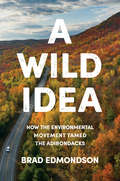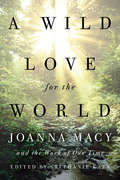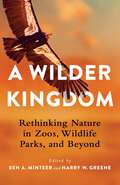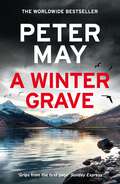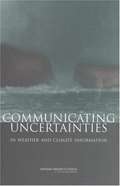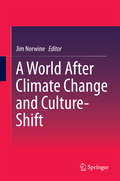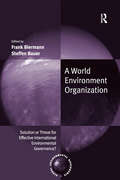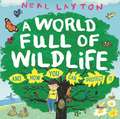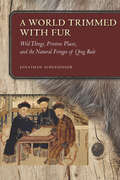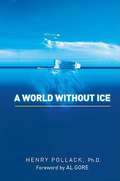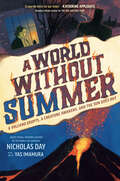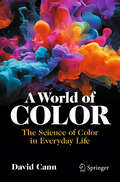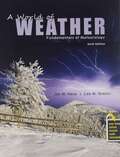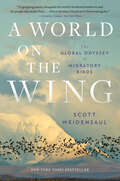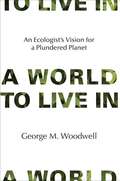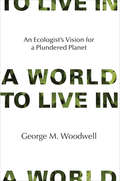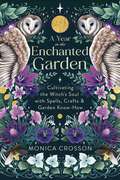- Table View
- List View
A Wild Idea: How the Environmental Movement Tamed the Adirondacks
by Brad EdmondsonA Wild Idea shares the complete story of the difficult birth of the Adirondack Park Agency (APA). The Adirondack region of New York's rural North Country forms the nation's largest State Park, with a territory as large as Vermont. Planning experts view the APA as a triumph of sustainability that balances human activity with the preservation of wild ecosystems. The truth isn't as pretty. The story of the APA, told here for the first time, is a complex, troubled tale of political dueling and communities pushed to the brink of violence. The North Country's environmental movement started among a small group of hunters and hikers, rose on a huge wave of public concern about pollution that crested in the early 1970s, and overcame multiple obstacles to "save" the Adirondacks. Edmondson shows how the movement's leaders persuaded a powerful Governor to recruit planners, naturalists, and advisors and assign a task that had never been attempted before. The team and the politicians who supported them worked around the clock to draft two visionary land-use plans and turn them into law. But they also made mistakes, and their strict regulations were met with determined opposition from local landowners who insisted that private property is private.A Wild Idea is based on in-depth interviews with five dozen insiders who are central to the story. Their observations contain many surprising and shocking revelations. This is a rich, exciting narrative about state power and how it was imposed on rural residents. It shows how the Adirondacks were "saved," and also why that campaign sparked a passionate rebellion.
A Wild Love for the World: Joanna Macy and the Work of Our Time
by Edited by Stephanie KazaJoanna Macy is a scholar of Buddhism, systems thinking, and deep ecology whose decades of writing, teaching, and activism have inspired people around the world. In this collection of writings, leading spiritual teachers, deep ecologists, and diverse writers and activists explore the major facets of Macy&’s lifework. Combined with eleven pieces from Macy herself, the result is a rich chorus of wisdom and compassion to support the work of our time. &“Being fully present to fear, to gratitude, to all that is—this is the practice of mutual belonging. As living members of the living body of Earth, we are grounded in that kind of belonging. Even when faced with cataclysmic changes, nothing can ever separate us from Earth. We are already home.&”— Joanna Macy
A Wilder Kingdom: Rethinking Nature in Zoos, Wildlife Parks, and Beyond
by Ben A. Minteer and Harry W. GreeneZoos have always had a troubled relationship to what is considered the “real” wild. Even the most immersive and naturalistic zoos, critics maintain, are inherently contrived and inauthentic environments. Zoo animals’ diet, care, and reproduction are under pervasive human control, with natural phenomena like disease and death kept mostly hidden from public view. Furthermore, despite their growing commitment to conservation and education, zoos are entertainment providers that respond to visitors’ expectations and preferences. What would a “wilder” zoo—one that shows the public a wider range of ecological processes—look like? Is it achievable or even desirable? What roles can or should zoos play in encouraging humanity to find meaningful connections with wild animals and places?A Wilder Kingdom is a provocative and reflective examination of the relationship between zoos and the wild. It gathers a premier set of multidisciplinary voices—from animal studies and psychology to evolutionary biology and environmental journalism—to consider the possibilities and challenges of making zoos wilder. In so doing, the contributors offer new insights into the future of the wild beyond zoos and our relationship to wild species and places across the landscape in an increasingly human-dominated era.
A Window into the Ocean Twilight Zone: Twenty-Four Days of Science at Sea
by Michelle CusolitoWant a front-row seat to cutting-edge ocean twilight zone technology? Climb aboard for twenty-four days of photo-illustrated science at sea! A fascinating middle-grade STEM book.Join scientists from Woods Hole Oceanographic Institution (WHOI) and international partner organizations on a research trip to study the ocean twilight zone using the newest technologies. Science writer Michelle Cusolito takes you along for the voyage of a lifetime. From moving onto the ship and unpacking equipment to facing massive storms while in the middle of the Atlantic Ocean, this book details the fascinating equipment used to study the deep ocean as well as day-to-day details such as what you eat on a Spanish research ship. Meet people and animals and learn more at sea than you ever imagined!&“From word one, Cusolito puts the reader smack into the action. Captivating creatures abound, coupled with important insights that impact our understanding of the ocean&’s role in our planet&’s sustainability. Perfectly titled, this book throws a window wide open, giving us an intimate look into the twilight zone.&” —Tanya Lee Stone, Sibert Medalist & NAACP Image Award Winner&“Michelle Cusolito captures the essence of high-seas research in A Window into the Ocean Twilight Zone. She skillfully guides the reader through what it&’s like to be a scientist at sea—the anticipation of departure, the challenges of heavy weather, and the thrill of discovery in one of the ocean&’s most remote and mysterious regions. In the process, she underscores the urgency behind advancing knowledge of Earth&’s last frontier—the ocean.&”—Peter de Menocal, President and Director of the Woods Hole Oceanographic Institution&“This spellbinding, real-life adventure will whisk you away with a team of scientists as they explore the wonders of the twilight zone. Michelle is a perfect guide to this remote realm and brilliantly shows what it's like to be a scientist working in challenging conditions. You&’ll learn about the importance of teamwork and patience, find out about the exciting technologies scientists use to study the deep sea, and see how discoveries about our living planet are made. This book will spark curiosity and is perfect for budding scientists.&”—Dr. Helen Scales, marine biologist and author of books for kids and adults, including What a Shell Can Tell and The Brilliant Abyss
A Wing and a Prayer: The Race to Save Our Vanishing Birds
by Anders Gyllenhaal Beverly GyllenhaalA captivating drama from the frontlines of the race to save birds set against the devastating loss of one third of the avian population. Three years ago, headlines delivered shocking news: nearly three billion birds in North America have vanished over the past fifty years. No species has been spared, from the most delicate jeweled hummingbirds to scrappy black crows, from a rainbow of warblers to common birds such as owls and sparrows. In a desperate race against time, scientists, conservationists, birders, wildlife officers, and philanthropists are scrambling to halt the collapse of species with bold, experimental, and sometimes risky rescue missions. High in the mountains of Hawaii, biologists are about to release clouds of laboratory-bred mosquitos in a last-ditch attempt to save Hawaii&’s remaining native forest birds. In Central Florida, researchers have found a way to hatch Florida Grasshopper Sparrows in captivity to rebuild a species down to its last two dozen birds. In the Sierra Nevada Mountains, a team is using artificial intelligence to save the California Spotted Owl. In North Carolina, a scientist is experimenting with genomics borrowed from human medicine to bring the long-extinct Passenger Pigeon back to life. For the past year, veteran journalists Anders and Beverly Gyllenhaal traveled more than 25,000 miles across the Americas, chronicling costly experiments, contentious politics, and new technologies to save our beloved birds from the brink of extinction. Through this compelling drama, A Wing and a Prayer offers hope and an urgent call to action: Birds are dying at an unprecedented pace. But there are encouraging breakthroughs across the hemisphere and still time to change course, if we act quickly.
A Winter Grave: From the worldwide bestselling author of THE BLACKHOUSE
by Peter MayFrom the twelve-million copy bestselling author of the Lewis trilogy comes a chilling new mystery set in the isolated Scottish Highlands.A TOMB OF ICEA young meteorologist checking a mountain top weather station in Kinlochleven discovers the body of a missing man entombed in ice.A DYING DETECTIVECameron Brodie, a Glasgow detective, sets out on a hazardous journey to the isolated and ice-bound village. He has his own reasons for wanting to investigate a murder case so far from his beat.AN AGONIZING RECKONINGBrodie must face up to the ghosts of his past and to a killer determined to bury forever the chilling secret that his investigation threatens to expose.Set against a backdrop of a frighteningly plausible near-future, A WINTER GRAVE is Peter May at his page-turning, passionate and provocative best.*PRE-ORDER THIS EXPLOSIVE NEW NOVEL NOW*
A Winter Grave: From the worldwide bestselling author of THE BLACKHOUSE
by Peter MayFrom the twelve-million copy bestselling author of the Lewis trilogy comes a chilling new mystery set in the isolated Scottish Highlands.A TOMB OF ICEA young meteorologist checking a mountain top weather station in Kinlochleven discovers the body of a missing man entombed in ice.A DYING DETECTIVECameron Brodie, a Glasgow detective, sets out on a hazardous journey to the isolated and ice-bound village. He has his own reasons for wanting to investigate a murder case so far from his beat.AN AGONIZING RECKONINGBrodie must face up to the ghosts of his past and to a killer determined to bury forever the chilling secret that his investigation threatens to expose.Set against a backdrop of a frighteningly plausible near-future, A WINTER GRAVE is Peter May at his page-turning, passionate and provocative best.*PRE-ORDER THIS EXPLOSIVE NEW NOVEL NOW*
A Winter Grave: a chilling new mystery set in the Scottish highlands
by Peter MayFrom the twelve-million copy bestselling author of the Lewis trilogy comes a chilling new mystery set in the isolated Scottish Highlands.A TOMB OF ICEA young meteorologist checking a mountain top weather station in Kinlochleven discovers the body of a missing man entombed in ice.A DYING DETECTIVECameron Brodie, a Glasgow detective, sets out on a hazardous journey to the isolated and ice-bound village. He has his own reasons for wanting to investigate a murder case so far from his beat.AN AGONIZING RECKONINGBrodie must face up to the ghosts of his past and to a killer determined to bury forever the chilling secret that his investigation threatens to expose.Set against a backdrop of a frighteningly plausible near-future, A WINTER GRAVE is Peter May at his best.(P) 2023 Quercus Editions Limited
A Word for Nature
by Robert L. DormanThe careers and ideas of four figures of monumental importance in the history of American conservation--George Perkins Marsh, Henry David Thoreau, John Muir, and John Wesley Powell--are explored in A Word for Nature. Robert Dorman offers lively portraits of each of these early environmental advocates, who witnessed firsthand the impact of economic expansion and industrial revolution on fragile landscapes from the forests of New England to the mountains of the West. By examining the nineteenth-century world in which the fourmen lived--its society, economy, politics, and culture--Dormansheds light on the roots of American environmentalism. Heprovides an overview of the early decades of both resourceconservation and wilderness preservation, discussing how Marsh, Thoreau, Muir, and Powell helped define the issues that began changing the nation's attitudes toward its environment by the early twentieth century. Dorman's readings of works including Marsh's Man and Nature, Thoreau's The Maine Woods, Muir's The Mountains of California, and Powell's Report on the Lands of the Arid Region reveal their authors' influence on environmental thought and politics even up to the present day.
A Workshop Summary Communicating Uncertainties in Weather and Climate Information
by Elbert W. FridayThe report explores how best to communicate weather and climate information by presenting five case studies, selected to illustrate a range of time scales and issues, from the forecasting of weather events, to providing seasonal outlooks, to projecting climate change.
A World After Climate Change and Culture-Shift
by Jim NorwineIn this book, an international team of environmental and social scientists explain two powerful current change-engines and how their effects, and our responses to them, will transform Earth and humankind into the 22nd-century (c. 2100). This book begins by detailing the current state of knowledge about these two ongoing, accelerating and potentially world-transforming changes: climate change, in the form of global warming, and a profound emerging shift of normative cultural condition toward the assumptions and values often associated with so-called postmodernity, such as tolerance, diversity, self-referentiality, and dubiety replaced with certainty. Next, the contributors imagine, explain and debate the most likely consequent transformations of human and natural ecologies and economies that will take place by the end of the 21st-century. In 16 compellingly original, provocative and readable chapters, A World after Climate Change and Culture-Shift presents a one-of-a-kind vision of our current age as a "hinge" or axial century, one driven by the most radical combined change of nature and culture since the rise of agriculture at the end of the last Ice Age some 10 millennia ago. This book is highly recommended to scholars and students of the environmental and social sciences, as well as to all readers interested in how changes in nature and culture will work together to reshape our world and ourselves. "I cannot think of a book more geared to advancing the art and science of geography. " - Yi-Fu Tuan, J. K. Wright and Vilas Professor Emeritus of Geography, University of Wisconsin-Madison"Outstanding," "unique," and "exceptional timeliness of topic and ambition ofvision". - Richard Marston, University Distinguished Professor, Kansas State University; past president, Association of American Geographers
A World Environment Organization: Solution or Threat for Effective International Environmental Governance? (Global Environmental Governance)
by Frank BiermannIn recent years, the debate on the establishment of a new international agency on environmental protection - a 'World Environment Organization' - has gained substantial momentum. Several countries, including France and Germany, as well as a number of leading experts and senior international civil servants have openly supported the creation of such a new international organization. However, a number of critics have also taken the floor and brought forward important objections. This book presents a balanced selection of articles of the leading participants in this debate, including both major supporters and opponents of creating a World Environment Organization. The volume is especially relevant to students and scholars of international relations, environmental policy and international law, as well as to practitioners of diplomacy, international negotiations, and environmental policy making.
A World Full of Wildlife: and how you can protect it
by Neal LaytonEvery animal and plant on earth is part of an incredible WEB OF LIFE. But living things are disappearing all over the world, and it's a big problem. Award-winning author-illustrator Neal Layton is here to introduce the concept of biodiversity to younger readers, explaining what it is, why it's so important, and how the actions of humans are hurting it. But he's also FULL of ideas for how you can help! From building a bug hotel to growing flowers on a windowsill and eating more organic food, A World Full of Wildlife will get young readers excited about how they can make a difference to keep the web of life bursting with energy.This brilliant non-fiction picture book is perfect for readers aged 5-7 who love nature and want to help the environment.Also available in this series:A Planet Full of PlasticA Climate in Chaos
A World Trimmed with Fur: Wild Things, Pristine Places, and the Natural Fringes of Qing Rule
by Jonathan SchlesingerIn the eighteenth and nineteenth centuries, booming demand for natural resources transformed China and its frontiers. Historians of China have described this process in stark terms: pristine borderlands became breadbaskets. Yet Manchu and Mongolian archives reveal a different story. Well before homesteaders arrived, wild objects from the far north became part of elite fashion, and unprecedented consumption had exhausted the region's most precious resources. In A World Trimmed with Fur, Jonathan Schlesinger uses these diverse archives to reveal how Qing rule witnessed not the destruction of unspoiled environments, but their invention. Qing frontiers were never pristine in the nineteenth century—pearlers had stripped riverbeds of mussels, mushroom pickers had uprooted the steppe, and fur-bearing animals had disappeared from the forest. In response, the court turned to "purification;" it registered and arrested poachers, reformed territorial rule, and redefined the boundary between the pristine and the corrupted. Schlesinger's resulting analysis provides a framework for rethinking the global invention of nature.
A World Without Ice
by Henry PollackA cowinner of the 2007 Nobel Peace Prize offers a clear-eyed explanation of the planet's imperiled ice. Much has been written about global warming, but the crucial relationship between people and ice has received little focus-until now. As one of the world's leading experts on climate change, Henry Pollack provides an accessible, comprehensive survey of ice as a force of nature and the potential consequences as we face the possibility of a world without ice. A World Without Ice traces the effect of mountain glaciers on supplies of drinking water and agricultural irrigation, as well as the current results of melting permafrost and shrinking Arctic sea ice-a situation that has degraded the habitat of numerous animals and sparked an international race for seabed oil and minerals. Catastrophic possibilities loom, including rising sea levels and subsequent flooding of low-lying regions worldwide. A World Without Ice answers our most urgent questions about this pending crisis, laying out the necessary steps for managing the unavoidable and avoiding the unmanageable.
A World Without Soil: The Past, Present, and Precarious Future of the Earth Beneath Our Feet
by Jo HandelsmanA celebrated biologist's manifesto addressing a soil loss crisis accelerated by poor conservation practices and climate change &“Jo Handelsman is a national treasure, and her clarion call warning of a looming soil-loss catastrophe must be heard. Add her clearly written alarm to other future-shocks: climate change, pandemics, and mass extinctions.&”—Laurie Garrett, Pulitzer Prize winner and author of The Coming Plague: Newly Emerging Diseases in a World out of Balance &“The ground beneath our feet is slipping away as we lose the precious soil that sustains us. Jo Handelsman&’s writing—as rich and life supporting as the soil itself—is a riveting warning.&”—Alan Alda, actor, writer, and host of the podcast &“Clear+Vivid with Alan Alda&” This book by celebrated biologist Jo Handelsman lays bare the complex connections among climate change, soil erosion, food and water security, and drug discovery. Humans depend on soil for 95 percent of global food production, yet let it erode at unsustainable rates. In the United States, China, and India, vast tracts of farmland will be barren of topsoil within this century. The combination of intensifying erosion caused by climate change and the increasing food needs of a growing world population is creating a desperate need for solutions to this crisis. Writing for a nonspecialist audience, Jo Handelsman celebrates the capacities of soil and explores the soil-related challenges of the near future. She begins by telling soil&’s origin story, explains how it erodes and the subsequent repercussions worldwide, and offers solutions. She considers lessons learned from indigenous people who have sustainably farmed the same land for thousands of years, practices developed for large-scale agriculture, and proposals using technology and policy initiatives.
A World Without Summer: A Volcano Erupts, A Creature Awakens, and the Sun Goes Out
by Nicholas DayThe true story of how a massive catastrophic eruption plunged the world into darkness, altering the global climate and inspiring the likes of Mary Shelley&’s Frankenstein—from the award-winning author of The Mona Lisa Vanishes and featuring black-and-white illustrations throughout.&“A tour-de-force for our times . . . At once a heart-stopping tale of climate change and a profoundly hopeful call to action.&”—Katherine Applegate, Newbery Medal winner for The One and Only IvanThe world was upside-down. The wind was fire. The sky was ash. The rain was rock.A couple of hundred years ago, on a quiet Indonesian island, a volcano called Tambora erupted with a force and violence that changed history.It tore apart the island, and in the months and years that followed, its fallout tore apart the world. The sun refused to shine; the rain refused to stop. Everything that everyone assumed would always be there—a world that made sense, a climate that made sense—was suddenly gone.From this riot of thunder and lightning, a young woman named Mary Shelley conceived of a scientist and his cursed creature. From the nightmare of Tambora, she wrote a nightmare of a book: Frankenstein—a terrifying reminder of how much damage we humans might do, without even realizing it.This is the story of a volcano that changed the world and a creature that changed us.Once upon a time, everything was different. And no one knew if it would ever be the same.In this masterful work, Nicholas Day, author of the Sibert Award–winning The Mona Lisa Vanishes, brings us a story taken from the archives but seemingly scripted for us today: a tale of climate change and human folly and hope—and what happens when the world suddenly goes wrong.
A World of Color: The Science of Color in Everyday Life (Copernicus Books)
by David CannThis book demystifies the intricate science behind the colors that surround us every day, making it accessible to readers of all backgrounds, from the crackling warmth of campfires to the iridescent glow of butterfly wings. Have you ever wondered why the sky appears blue, or why leaves turn golden in the fall? How do our eyes perceive color, and why do some creatures see the world in hues we can only imagine? Delve into the captivating world of color with this informative and engaging book as your guide. A rich assortment of colorful figures and photographs accompanies you on a journey from the tranquil depths of the ocean to the shimmering neon lights of the urban cityscape. You'll learn how things like fluorescence, refraction, and interference allow artists to manipulate color to evoke emotion, and how scientists harness it to revolutionize technology. How does the color of fireflies inspire cutting-edge display devices, and what can the mantis shrimp teach us about the evolution of color vision? Prepare to be dazzled as you embark on a journey through the spectrum of discovery. Are you ready to see the world in a new light?
A World of Weather: Fundamentals of Meteorology
by Lee M. Grenci Jon M. NeseA World of Weather: Fundamentals of Meteorology presents basic principles that enable students to gain a “thorough possession” of the underlying scientific principles of meteorology and to be able to think critically about them. This text shows how fundamental concepts fit together to form a conceptual pyramid that explains how the atmosphere really works. It shows students how to apply the concepts learned by offering examples based on real weather data.
A World on the Wing: The Global Odyssey Of Migratory Birds
by Scott WeidensaulNew York Times Bestseller Finalist for the Los Angeles Times Book Prize A Library Journal Best Science and Technology Book of the Year An exhilarating exploration of the science and wonder of global bird migration. In the past two decades, our understanding of the navigational and physiological feats that enable birds to cross immense oceans, fly above the highest mountains, or remain in unbroken flight for months at a stretch has exploded. What we’ve learned of these key migrations—how billions of birds circumnavigate the globe, flying tens of thousands of miles between hemispheres on an annual basis—is nothing short of extraordinary. Bird migration entails almost unfathomable endurance, like a sparrow-sized sandpiper that will fly nonstop from Canada to Venezuela—the equivalent of running 126 consecutive marathons without food, water, or rest—avoiding dehydration by "drinking" moisture from its own muscles and organs, while orienting itself using the earth’s magnetic field through a form of quantum entanglement that made Einstein queasy. Crossing the Pacific Ocean in nine days of nonstop flight, as some birds do, leaves little time for sleep, but migrants can put half their brains to sleep for a few seconds at a time, alternating sides—and their reaction time actually improves. These and other revelations convey both the wonder of bird migration and its global sweep, from the mudflats of the Yellow Sea in China to the remote mountains of northeastern India to the dusty hills of southern Cyprus. This breathtaking work of nature writing from Pulitzer Prize finalist Scott Weidensaul also introduces readers to those scientists, researchers, and bird lovers trying to preserve global migratory patterns in the face of climate change and other environmental challenges. Drawing on his own extensive fieldwork, in A World on the Wing Weidensaul unveils with dazzling prose the miracle of nature taking place over our heads.
A World to Live In
by George M. WoodwellA century of industrial development is the briefest of moments in the half billion years of the earth's evolution. And yet our current era has brought greater changes to the earth than any period in human history. The biosphere, the globe's life-giving envelope of air and climate, has been changed irreparably. In A World to Live In, the distinguished ecologist George Woodwell shows that the biosphere is now a global human protectorate and that its integrity of structure and function are tied closely to the human future. The earth is a living system, Woodwell explains, and its stability is threatened by human disruption. Industry dumps its waste globally and makes a profit from it, invading the global commons; corporate interests overpower weak or nonexistent governmental protection to plunder the planet. The fossil fuels industry offers the most dramatic example of environmental destruction, disseminating the heat-trapping gases that are now warming the earth and changing the climate forever. The assumption that we can continue to use fossil fuels and "adapt" to climate disruption, Woodwell argues, is a ticket to catastrophe.But Woodwell points the way toward a solution. We must respect the full range of life on earth -- not species alone, but their natural communities of plant and animal life that have built, and still maintain, the biosphere. We must recognize that the earth's living systems are our heritage and that the preservation of the integrity of a finite biosphere is a necessity and an inviolable human right.
A World to Live In: An Ecologist's Vision for a Plundered Planet
by George M. WoodwellA scientist makes a powerful case that preservation of the integrity of the biosphere is a necessity and an inviolable human right.A century of industrial development is the briefest of moments in the half billion years of the earth's evolution. And yet our current era has brought greater changes to the earth than any period in human history. The biosphere, the globe's life-giving envelope of air and climate, has been changed irreparably. In A World to Live In, the distinguished ecologist George Woodwell shows that the biosphere is now a global human protectorate and that its integrity of structure and function are tied closely to the human future. The earth is a living system, Woodwell explains, and its stability is threatened by human disruption. Industry dumps its waste globally and makes a profit from it, invading the global commons; corporate interests overpower weak or nonexistent governmental protection to plunder the planet. The fossil fuels industry offers the most dramatic example of environmental destruction, disseminating the heat-trapping gases that are now warming the earth and changing the climate forever. The assumption that we can continue to use fossil fuels and “adapt” to climate disruption, Woodwell argues, is a ticket to catastrophe.But Woodwell points the way toward a solution. We must respect the full range of life on earth—not species alone, but their natural communities of plant and animal life that have built, and still maintain, the biosphere. We must recognize that the earth's living systems are our heritage and that the preservation of the integrity of a finite biosphere is a necessity and an inviolable human right.
A Year in the City (Season to Season)
by Christina Mia GardeskiFrom snow plows to skyscraper nests and rooftop gardens, life in the city changes from season to season. Discover what animals live in the city. Learn how smog forms in summer. Real-life photographs follow the seasons and capture the beauty of a year in the city.
A Year in the Enchanted Garden: Cultivating the Witch's Soul with Spells, Crafts & Garden Know-How
by Monica CrossonStep onto the Garden Path with a Year of Spells, Stories & SoilDig into your Witchcraft with month-by-month gardening guidance for flowers, herbs, vegetables, trees, and more. Featuring dozens of spells, charms, and activities, this hands-on book helps you select, grow, and harvest the best plants for your region and shows you how to use them in your magickal practice.Monica Crosson devotes three chapters to each month, sharing both practical and magickal tips on timely garden tasks. Her inviting collection blooms with stories, recipes, and crafts as well as correspondences for stones, colors, animals, zodiac signs, and more.Deepen your connection to Mother Nature with thirteen Celtic tree month full moon rituals. Revel in the rich folklore, sabbat celebrations, and garden-based deities. Whatever hardiness zone you hail from, A Year in the Enchanted Garden will nurture your love of plants and guide you through growing your most plentiful garden yet.
A Year in the Forest (Season to Season)
by Christina Mia GardeskiFrom hibernation to baby animals and falling leaves, life in the forest changes from season to season. Discover why snow is good for trees. Learn how wildfires help the forest grow. Real-life photographs follow the seasons and capture the beauty of a year in the forest.
